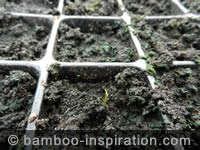- Home ›
- Bamboo Plants ›
- Bamboo Propagation
Bamboo Propagation
Bamboo propagation usually involves taking parts of established bamboo plants and using the pieces to grow new plants.
This can be done by division, layering, or cuttings.
Alternatively you can grow new plants from seed if you can obtain the seeds.
Whether a particular method is used will be dependent on the species, the age of the plant, and the environmental conditions suitability for the plant are present.
Seed
Growing from seed is not the most popular or successful method as the seeds may be hard to obtain.
Bamboo Seeds for Sale - eBay Affiliate
(As an eBay Partner, I may be compensated if you make a purchase)

Flowering patterns are known to be unpredictable, unreliable, and erratic with some rarely flowering at all. The flowering of bamboos is very much species and environment dependent.
Although there are some species that flower consistently there are also some, often tropical species, that only flower between 30 to over 80, or even over 100 years apart.
Sometimes clumps of an entire species will flower, produce seed, and then die. But it's not known what induces such flowering.
Bamboo Seeds - Germinating Seeds - Potting Seedlings - Bamboo Flowers
Bamboo Propagation Through Division
Bamboos can be propagated by lifting their rhizome shoots. As a secondary benefit, this method can also help with control of the spread of running species. Basically you get two jobs done all at the same time!
Bamboo propagation by division of the parent plant can be carried out on bamboos that have been grown in containers or in the ground.
The best time of year to do this is the growing season, during the in spring and early summer, again dependent on your climate and global location.
The plants underground system of roots and rhizomes provides opportunity to divide off one or more culms to make new plants. This technique is more likely to be successful when the parent plant is healthy and pest free and appropriate care of the new division is taken.
Often cutting off a single culm with a healthy budding rhizome will be enough to result in a new clump of bamboo but you will achieve a much better plant by removing more than one culm that are joined at the base. You will have provided a much better chance for success for generating the new plant with two or more culms.
Rhizome shoots are connected to the root ball underground, are very hardy, and can be pretty tough to cut. Use a sharp spade, secateurs, or some loppers for this job. Try to cut it off quite close to the root ball so you leave a tidy cut.
Dig the young rhizome shoot out carefully while watching that you don't damage the roots. Once you have them out of the ground it is important not to let them dry out, I usually put them in a bucket of water temporarily.
Please be careful not to damage the parent plant, particularly if you are taking the division from a relatively young clump. It is better to divide from a well established plant.
While you are working on your bamboo propagation do not let any part of the plant dry out. Ensure you keep it moist during the operation, while transporting, transplanting bamboo, and during storage.
It is best if you have already prepared your ground or pot ready to transplant the young plant to. If your new clump doesn't quite fit into the hole or container trim it down a bit with secateurs.
Once planted be sure to water it in well.
You can also shorten the top growth by up to half which will help reduce transpiration while the new plant gets established in its new home.
Gardening Tools for Sale - eBay affiliate
(As an eBay Partner, I may be compensated if you make a purchase)
Layering
New plants can also be propagated using the layering method.
Layering is done by pulling the culm down to the ground and covering over with a good layer of soil and/or mulch to enable rooting to take place.
Once the new plant has established it can be separated from the parent plant and transplanted to it's new location.
This can be a successful way to get new plants to form at the nodes while still attached to the parent plant.
It is a popular technique because you do not have to maintain it except from ensuring it does not dry out in hot weather or become waterlogged.
However, you may need to leave it attached to the parent plant for up to two years to achieve a good strong plant that is established enough to withstand transplanting.
Bamboo Seeds for Sale - eBay Affiliate
(As an eBay Partner, I may be compensated if you make a purchase)
Air Layering
Air layering involves using the same air layering technique as is used on trees where you apply a rooting medium to a node on the culm and wrap it in a potting mix until it takes root.
Once roots are formed you can separate it from the culm and transplant to the desired location.
I tried air layering using sphagnum moss as I have occasionally to get bonsai trees but I was unsuccessful in getting it to work! Having said that, perhaps I didn't take enough care with my preparation or sphagnum moss doesn't work with bamboo propagation, and I may attempt it again sometime.
Bamboo Propagation Cuttings
You can also try taking cuttings for bamboo propagation. I have not personally tried taking cuttings but I understand that, although it does not involve as much work, is less likely to be successful.